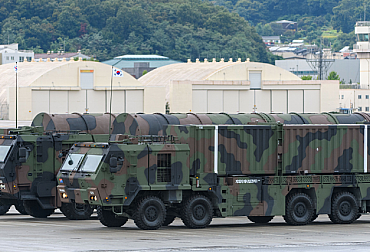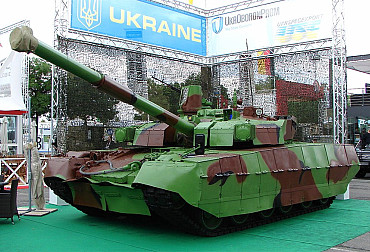M903 Launchers for Polish Patriot systems. Major contracts to modernise the Polish Army ahead
A contract for the supply of 48 M903 launchers for Polish Patriot air defense systems was signed in the presence of Polish Deputy Prime Minister and head of the Ministry of Defense Władysław Kosiniak-Kamysz.
In March 2018, Poland confirmed the purchase of two Patriot PAC-3+ air defense batteries from the United States for $4.75 billion. However, particularly in view of the war in Ukraine, there was no question of stopping there. Hence the launch of the second phase of its Wisla program. In June 2023, the Defense Security Cooperation Agency (DSCA), which is responsible for U.S. military equipment exports, recommended that Congress accept the potential sale to Poland of 48 Patriot M903 launchers, an Integrated Air and Missile Defense Battle Command System (IBCS), 12 LTAMDS radars and 644 PAC 3 MSE interceptor missiles.

Contract negotiations were quickly concluded, with the order for these systems officially signed by the Polish Ministry of Defense in September 2023, for a total value of more than 11 billion dollars. However, it demanded industrial compensation. And these have just materialised.
The contract, signed between Raytheon Poland and Huta Stalowa Wola S.A., sets out the terms and conditions for the production and delivery of 48 anti-aircraft and anti-missile launchers. It is a subcontract agreement. The Polish company will manufacture the launchers for the US company, and then they will be integrated into the entire system and delivered between 2027 and 2029. Deputy Prime Minister Władysław Kosiniak-Kamysz emphasised the importance of this investment for Poland's security during the signing ceremony, saying: "We are starting the week of the Polish Army, the finale of which will be a parade – parade of strength and unity. This week will also be full of events important for Poland's security. The economy and the armed forces must go together. Today, in Sochaczew, we are beginning to sign major contracts to modernise our military."
The Minister of Defense also stressed the importance of cooperation with the United States, saying: "Today, Poland is among those countries in Europe that have the greatest trust from the United States. This is evidenced by the transfer of the latest technologies to us. Poland was the first and only country to obtain the IBCS system." The concluded agreement follows an intergovernmental agreement (FMS) for the second phase of the Wisla program, including 48 M903 launchers along with several hundred PAC-3 MSE missiles, and was concluded in September 2023. Under this agreement, the U.S. government, in accordance with the FMS procedure, is commissioning the contractor.
For the second phase of the Wisla program, Poland also procured LTAMDS radars (also in September 2023) and the IBCS battle management system (in February 2024, the IBCS will also be used in more than 20 batteries of the Narew system). The total value of the signed contracts is more than $11 billion, of which more than $9 billion is for LTAMDS launchers, missiles, and radars.
In the production process, Huta Stalowa Wola will make use of the competencies obtained in the first phase of the Narew program, both through offsets and business-to-business (B2B) cooperation. HSW's most important sub-suppliers for the contract include Zakłady Mechaniczne Tarnów S.A., supplying actuators for the launchers, and Wojskowe Zakłady Elektroniczne S.A., responsible for the supply of the Data Link Terminal Module. Already in the first phase, companies in the PGZ-Wisla consortium produced a number of other elements of the Patriot systems, including technical support containers, transport and loading vehicles, launcher components, missile components, and radar systems.
The MIM-104 Patriot PAC-3 long-range anti-aircraft system
The MIM-104 Patriot PAC-3 long-range anti-aircraft system is an evolution of the model that appeared in the mid-1980s, intended as a counterpart to the Russian S-300, which had entered service a few years earlier. Its early versions were highly controversial, particularly during the first Gulf War, when the actual interception rate was well below the 97% announced by President George H. W. Bush. The system was subsequently upgraded several times to improve its performance. The latest version, known as PAC-3, incorporates the capabilities of the PAC-2 GEM version (improved following the Gulf War), since it can use both PAC-2 and PAC-3 missiles.
The Patriot PAC-3 has gradually come into the limelight since its recent export successes, especially since two batteries were supplied to Ukraine, one by the United States and the other by Germany. As soon as it was credited with destroying several Kinzhal and Iskander-M missiles, it went from being an "unloved" system to being "the best performing system in the world".
The general architecture of the MIM-104 PAC-3 has not changed. The battery still comprises an AN/MPQ-65 or AN/MPQ-65A fire control radar replacing the AN/MPQ-53 of earlier versions, an AN/MSQ-32 Engagement Control Station (ECS) command vehicle with three operators, an OE-349 Antenna Mast Group vehicle for connection to UHF data links (Link 16), an EPP-III energy vehicle and 4 to 8 M902/903 missile launch vehicles. Like its predecessor, the AN/MPQ-65 is a PESA electronically scanned radar operating in G-band, i.e. around 5 GHz. Its detection range is thought to exceed 170 km. The AN/MPQ-65A is the AESA version of the radar and was developed for the PAC-3 MSE version. The radar's detection capabilities remain more or less the same.
The Patriot PAC-3 can use three types of missiles:
- 1) the missile developed for the PAC-2 is a 900kg missile with 84kg of explosive charge and a maximum range of 160km. It was designed to be able to deal with all types of target (intermediate-range ballistic missiles, aircraft, cruise missiles, drones, etc.) up to an altitude of 32,000 m. Its semi-active seeker makes it particularly suitable for high-altitude targets;
- 2) the missile developed for the PAC-3 is a much more compact 315 kg missile with a very small warhead of just 8.2 kg. Its small size means that it can be integrated on M903 launchers, with 16 missiles per launcher compared with just 4 for the previous missile. This missile has been optimised to intercept ballistic missiles, but it can also deal with any other flying target. It has a range of 70km (20 km against ballistic missiles) and a maximum altitude of 24,000 m. It has an active seeker and 180 thrusters (ACM), located on the front of the missile, enabling it to fine-tune its trajectory in order to "hit to kill", i.e. physically impact the target, which explains the low warhead;
- 3) the PAC-3 MSE version is an evolution of the previous missile, with an improved range of 100km (30km against ballistic missiles) up to an altitude of 36,000m. It is also equipped with a slightly larger warhead. Slightly larger than its predecessor, it can still be fitted on M903 launchers, but only 12 missiles per launcher.









